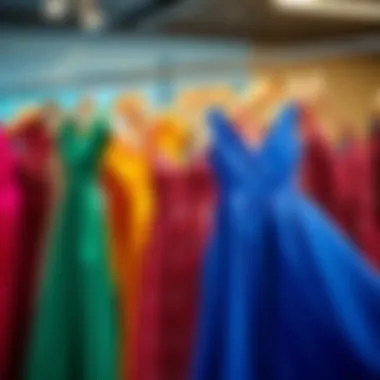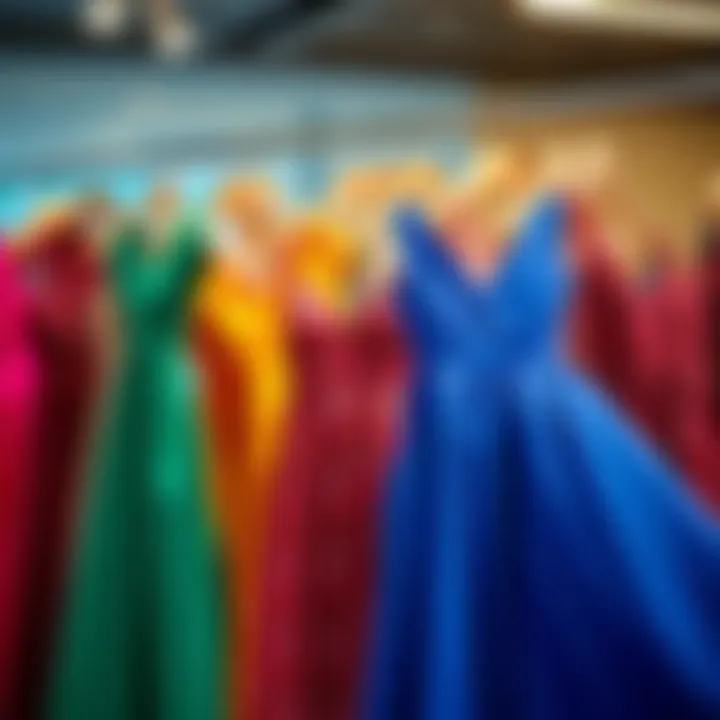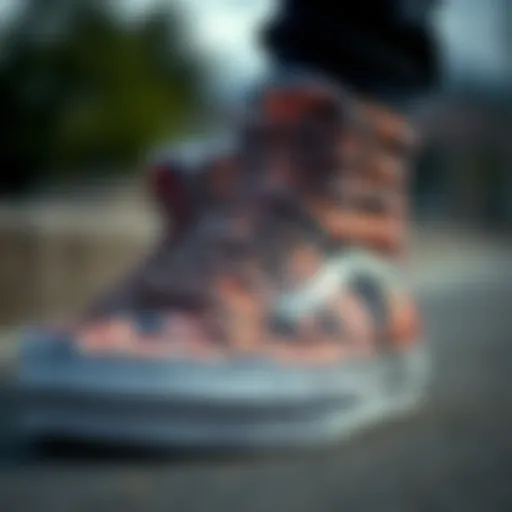Ladies' Trendy Dresses: Styles, Fabrics, and Insights


Intro
The world of women's fashion is constantly morphing. When we talk about ladies' dresses, it's no mere fabric draped around a body. These garments serve as a mirror reflecting changes in society, culture, and personal identity. To explore the landscape of ladies' trendy dresses, one must first understand the beating heart that drives today's fashion trends. Not simply about looking good, trendy dresses encapsulate a narrative that includes body positivity, sustainability, and a connection to one's individual style.
As we delve into the realm of these stylish pieces, we encounter more than just seasonal must-haves or iconic silhouettes that have graced runways throughout the decades. Each dress carries with it a story, a testament to evolving fashion ideals. The appeal is not just skin-deep; it engages consumers on emotional and ethical levels. From cutting-edge fabric innovations to the latest styling tips, our exploration aims to equip fashion enthusiasts, retailers, stylists, and bloggers with insights that push the envelope of contemporary aesthetics.
Let’s kick things off by examining key clothing trends that have defined today’s landscape, offering a roadmap that reflects not just what’s in vogue, but more importantly, why these choices resonate with modern women.
Prolusion to Ladies' Trendy Dresses
In today’s rapidly evolving world of fashion, the domain of ladies' trendy dresses holds a place of paramount significance. This section aims to unpack the various elements that contribute to this importance, enticing both fashion enthusiasts and industry professionals alike.
Trendiness in the realm of women's dresses is not simply about following the latest styles; it encompasses a broader cultural dialogue concerning identity, expression, and even sustainability. As society shifts toward more inclusive ideals, the conception of what constitutes a fashionable dress is expanding, allowing for greater diversity in shapes, sizes, and designs.
Understanding the facets of ladies' trendy dresses can yield several benefits:
- Personal Expression: Dresses are often seen as a canvas for personal identity. The styles one chooses to wear can convey much about their tastes, preferences, and even values. A well-selected dress can speak volumes, turning heads and leaving a lasting impression.
- Cultural Reflection: Fashion is inherently linked to cultural movements. Dresses that gain popularity often reflect not just aesthetic choices but broader societal themes. This is especially true in today’s landscape, where movements around body positivity and sustainability are influencing dress styles.
- Market Dynamics: For retailers and designers, understanding trends in women's dresses can be a goldmine. Recognizing shifts not only helps in anticipating consumer needs but can lead to innovative designs that resonate with audiences.
- Sustainability Considerations: Modern consumers are increasingly leaning towards eco-friendly options. Fashion choices now reflect an awareness of environmental impact, encouraging brands to innovate with sustainable materials and practices.
As we embark on this exploration of ladies' trendy dresses, we open the door to a myriad of discussions surrounding the latest styles, cultural implications, and the transformative journey of this ever-evolving fashion segment. With branches extending from historical context to the latest innovations in fabric, the insights gleaned will equip readers with a robust understanding of how to navigate this vibrant landscape.
"Fashion is an extension of our personality, and dresses are at the heart of it all. Understanding their journey is to understand our own evolving narratives in style and expression."
In summary, the importance of ladies' trendy dresses extends well beyond the fabric; it is a reflection of identity, a response to societal change, and a beacon guiding future trends. As we delve deeper into this topic, we will dissect the nuances that make trendy dresses a vital part of contemporary fashion.
Defining Trendiness in Fashion
When we talk about trendiness, we’re not solely referring to the latest craze that flits across social media timelines or the fashion shows. It’s a complex dance of influences, history, and social considerations that shapes how we perceive style in today's world. Defining trendiness in fashion isn't just about identifying what’s hot at a given moment; it’s about understanding the undercurrents driving those trends and how they resonate with individuals.
There are specific elements that play significant roles in shaping the concept of trendiness. First off, one cannot ignore the cultural context. This includes everything from economic conditions to social movements, and how these elements intertwine with people's emotions. For instance, the rise in sustainable fashion reflects a growing awareness of environmental issues, something that has increasingly become a part of fashion discourse. This change indicates that trendiness is not a shallow notion but a responsive framework to the world around us.
Moreover, fashion is multilayered. It defines how people choose to express themselves based on their identity, beliefs, and even aspirations. The resurgence of vintage styles shows how nostalgia plays into trendiness; people often gravitate toward items that bring a sense of comfort or belonging. Fashion as identity, too, suggests that wearing a particular trend can be a statement about who you are rather than just an aesthetic choice. This broadens the understanding of what it means to be fashionable and underscores fashion’s role as a vehicle for self-expression.
Benefits of Understanding Trendiness
- Informed Choices: By understanding the trends, consumers are empowered to make informed decisions that align with their values.
- Cultural Connection: Recognizing the origins of trends helps engage with broader cultural narratives, enhancing a person's engagement with fashion.
- Innovation for Designers: Designers can better anticipate what consumers are looking for, encouraging innovation and thoughtful creativity.
Considerations About Defining Trendiness
However, it’s crucial to consider that trendiness can sometimes appear superficial, potentially encouraging the fast fashion cycle. This is where garments are produced quickly to capitalize on trends, often at the expense of ethical production practices and quality. Understanding the depth behind what trendiness really means can foster a more conscious approach to fashion, pushing individuals toward sustainable practices.
This multilayered understanding of fashion is essential whether you’re a consumer, a designer, or simply someone passionate about style. As trends continue to evolve based on societal inputs, the narrative of fashion will continually shift, reflecting the dynamic tapestry of human experience.
"Fashion is the armor to survive the reality of everyday life." – Bill Cunningham
In summary, defining trendiness in fashion involves recognizing its various influences and implications, driving many to approach their wardrobes with more thoughtfulness and intention. The more we understand what is trendy and why, the better equipped we are to navigate not just the clothes we wear, but the cultural landscape from which those styles emerge.
For more in-depth explorations of fashion trends and cultural influences, refer to resources such as Wikipedia, Britannica and fashion communities on Reddit.
Historical Context of Dresses
Understanding the historical context of dresses is pivotal when exploring ladies' trendy attire. It not only provides insight into the evolution of fashion but also reflects the societal norms and cultural shifts of different eras. Each dress tells a story, merging individual identity with broader trends, and by examining this relationship, we can grasp the significance of style choices in today's world.
Evolution Through the Decades
Dresses have undergone a remarkable metamorphosis, shaped by the times they were born into.
- 1920s: The Roaring Twenties heralded a revolution in women's fashion, with the introduction of the flapper dress. These garments were characterized by their loose fit and dropped waist, symbolizing freedom and independence that women fought for. It was a bold statement against the constraints of previous decades.
- 1950s: The mid-century saw the emergence of the iconic A-line silhouette. Designers like Christian Dior popularized the New Look, which emphasized a narrow waist and full skirt, epitomizing femininity. This era was also marked by post-war optimism, leading to affluent lifestyles and fashion choices that reflected a desire to return to traditional values.
- 1970s: The disco era brought a kaleidoscope of patterns and styles; the introduction of maxi dresses and wrap dresses catered to a generation seeking comfort and expression. This was a time of social upheaval and cultural questioning, mirrored in the designs that broke conventions.
- 2000s and Beyond: Fast forward to the 21st century, where the fast fashion movement redefined production and consumption. Dresses now cater to an even broader audience, with varied styles from the vintage-inspired to high-tech fabrics. The rise of online shopping has made these trends more accessible than ever.
Cultural Shifts and Dress Styles
Dresses have not only mirrored fashion trends; they've also encapsulated cultural shifts,
- Gender Roles: In the mid-20th century, dresses often reinforced traditional gender roles. Shifts in these dynamics led to a reevaluation of how dresses are perceived and worn by women. The rise of androgynous fashion in recent years reflects a growing acceptance of non-binary identities.
- Inclusivity: Recent years have spotlighted body positivity, forcing brands to reconsider their offerings. The push for diverse sizing means that dresses are not just made for the 'ideal' body type, but cater to a range of shapes and sizes, promoting a more inclusive conversation around fashion.
"Fashion is not just about clothing; it's a reflection of cultural identity and societal change."
- Sustainability: Over the past decade, there has been a surge in awareness regarding the environmental impact of fashion choices. As such, designers have turned to sustainable materials, leading to a rise in dresses made from organic cotton and recycled polyester.
By recognizing the historical context of dresses, we not only honor those who came before us but also equip ourselves to navigate the current fashion landscape. The journey of dresses through time illustrates how intertwined they are with cultural narratives, making them far more than just pieces of fabric.
Current Trends in Ladies' Dresses
In today's fashion realm, one cannot overlook the significance of the current trends that shape ladies' dresses. The style landscape is ever-evolving, influenced by cultural shifts, technological innovations, and societal trends. Understanding these current trends is vital as they reflect the collective preferences and aspirations of women everywhere. Not only do these trends dictate the trending styles for the season, but they also highlight important considerations like comfort, sustainability, and individuality in dressing.
Key Styles Dominating the Market


Maxi Dresses
Maxi dresses are making waves for their versatility and elegance. These long, flowy garments often give off a relaxed yet chic vibe, making them a favorite among many fashion enthusiasts. The key characteristic of a maxi dress lies in its length, which allows it to be worn for various occasions, from casual outings to more formal events. This adaptability is a major reason why maxis have become a staple in many closets.
The unique feature of maxi dresses is their ability to flatter a variety of body types. With numerous styles available, such as those with fitted bodices or loose silhouettes, women can find one that suits their personality and comfort level. While they tend to be worn in warmer seasons, with the right layering and accessories, maxi dresses can transition into cooler months, proving to be a sound investment.
Mini Dresses
When it comes to fun and flirty styles, mini dresses reign supreme. Their short hemline, often above the knee, makes them a popular choice for various occasions, particularly during warmer weather. Mini dresses have a playful essence that few other styles can capture, which makes them a go-to for social gatherings and nights out.
One noteworthy aspect of mini dresses is their capacity for bold fashion statements. These dresses often feature vibrant colors and striking patterns, allowing wearers to showcase their personality. Despite their playful nature, mini dresses can sometimes leave wearers feeling exposed, requiring consideration in terms of comfort and confidence levels.
A-Line Dresses
A-line dresses have carved their niche as classics that never seem to go out of style. This silhouette, which flares out from the waist, creates a flattering shape that suits women of all body types. The elegance of an A-line dress makes it suitable for both casual and formal events, from garden parties to office settings.
The unique quality of A-line dresses is their inherent ability to emphasize the waist while providing ample room for movement. This contributes to their popularity, especially among those who value both style and comfort. However, while A-line dresses remain a well-loved option, they may sometimes be perceived as less edgy compared to other contemporary styles.
Wrap Dresses
Wrap dresses bring a level of sophistication and ease that many seek in their wardrobe. Characterized by a front closure that wraps around the body, these dresses accentuate curves beautifully. The key characteristic of a wrap dress is its adjustable fit, allowing for a tailored silhouette that can enhance the natural figure.
The remarkable feature of wrap dresses is their versatility—they can be dressed up for formal occasions or down for casual outings. This adaptability makes them a beneficial addition to any wardrobe. However, the delicate wrapping mechanism requires some care during wear to avoid wardrobe malfunctions.
Color Palettes and Patterns
Monochrome Trends
In a world filled with vibrant colors and prints, monochrome trends stand out for their simplicity and sophistication. Dressing in a single color can create a bold yet cohesive look that exudes confidence and style. The benefit of monochrome outfits is their ease of coordination and the sleek look they provide.
Monochrome dresses often allow room for creativity through layering and accessorizing. Though this type of dressing can sometimes be viewed as minimalistic, those who embrace it often find ways to play with textures and hues within the same color family, creating depth.
Floral Prints
Floral prints continue to hold a timeless appeal in ladies' fashion. They evoke feelings of freshness and femininity, often associated with spring and summer seasons. The charm of floral dresses lies in their ability to bring a lively and bright touch to an outfit.
With a wide array of floral patterns available—from dainty blooms to bold, large designs—there's an option for everyone. Though floral prints can sometimes be overly reminiscent of specific seasons, their versatility allows them to be worn throughout the year with the right styling.
Geometric Designs
For those who favor a more modern aesthetic, geometric designs present a stylish choice. The structured shapes and lines create a unique visual appeal that can be both sophisticated and edgy. These designs draw attention and can be conversation starters, making them a popular choice for fashion-forward individuals.
However, geometric patterns may also have their drawbacks. Such bold prints can sometimes feel limiting in terms of accessorizing, as finding the right companions can be a challenge. Yet, for those willing to experiment, they offer a striking way to stand out.
Fabric Innovations and Choices
The fashion world is continually evolving, and at the heart of this progression lies the innovation in fabrics. Various decisions related to fabric choices can significantly shape ladies' trendy dresses. Acknowledging what materials are applied can enhance both style and function. This section dives into significant developments in fabric, assessing their role in modern fashion.
Sustainable Fabrics in Fashion
Organic Cotton
Organic cotton has gained traction as a solid alternative to conventionally grown cotton. The core characteristic of organic cotton lies in its production process, which avoids harmful pesticides and fertilizers. This grain of understanding is vital as it aligns with the growing global movement towards sustainability. Choosing organic cotton not only diminishes environmental harm but also usually results in softer fabric textures.
Uniquely, organic cotton can translate into health benefits. Many individuals with sensitive skin find it less irritating than traditional cotton. However, it’s worth noting that compared to conventional cotton, organic cotton can sometimes come at a higher price point. This cost can deter some consumers, but many are willing to pay the premium for the benefits it provides.
Recycled Polyester
Recycled polyester is another innovative fabric making waves in the women's fashion realm. Following its significant growth, it has become a favored choice among eco-conscious brands and consumers. The key characteristic that sets recycled polyester apart is its origin; it’s made from repurposed plastic bottles and textile waste. This process reduces landfill waste and lessens overall environmental impact.
The uniqueness of recycled polyester not only lies in its manufacturing but also in its versatility. It can mimic various textures, from cotton to silk, providing a broad appeal to diverse lifestyles. Yet, there are drawbacks; for instance, the longevity and durability of products made from recycled polyester can be questioned. Some purists argue that real organic fibers outperform it in terms of breathability. Still, it remains a popular choice for those wanting to make environmentally conscious fashion decisions.
Comfort Meets Style
Breathable Materials
In an age where comfort is often prioritized alongside aesthetics, breathable materials are increasingly sought after. These fabrics allow for air circulation, which enhances comfort. The primary allure is their ability to keep the wearer cool, especially in warmer months. Cotton blends, linen, and certain technical synthetics are often chosen for their lightweight and breathable properties.
This unique feature of breathability does not compromise style; dresses made from these materials can retain structure and elegance while providing comfort. However, some breathable fabrics may lack durability in the long run, as they may wear out faster than sturdier options. This is a consideration for those wanting longevity in their wardrobe.
Stretchable Fabrics
Stretchable fabrics have emerged to meet the changing needs of women's fashion. With lifestyle shifts toward more active pursuits, stretchable materials offer style with flexibility. The key characteristic of these fabrics is their elasticity, which allows for a greater range of movement, ensuring that fashion is not just about standing still.
These materials often feature knits and blends, such as Spandex or elastane, enabling them to hug curves nicely without an uncomfortable fit. The unique feature of stretchable fabric is its adaptability: it can be worn during leisure, work, or even athletic activities. However, a downside to consider is that over time, elastic fibers can lose their stretch, leading to a less flattering fit as the garment ages.
Styling Tips for Trendy Dresses


When it comes to ladies' trendy dresses, styling can make or break the look. Understanding how to dress effectively not only enhances an outfit but also empowers individuals, allowing them to express their personality through clothing choices. Each element of style—from the accessory of the dress to the right layering—is crucial in crafting a complete and visually appealing ensemble. Knowing how to combine different elements allows women to feel confident, fashionable, and ready for any occasion.
Accessorizing Effectively
Accessorizing is that cherry on top of a sundae; it can take an outfit from drab to fab in no time. The right bags and footwear can complement a dress beautifully, making decision making an art in itself.
Bags and Footwear Choices
Bags and footwear are not merely functional; they play a pivotal role in how a dress is perceived. For example, a chic clutch with a mini dress can elevate the outfit, adding sophistication without overwhelming the overall look. Similarly, pairing a maxi dress with strappy sandals enhances its flowy aesthetic, making it ideal for summer outings or beach days.
The key characteristic here is versatility. Bags, whether they're crossbody or totes, come in a myriad of styles and colors, allowing women to tailor their look to fit any occasion. Footwear also greatly influences style; choosing between heels, sneakers, or flats can shift the vibe entirely.
Advantages:
- Offers a chance to introduce color or texture.
- Creates a comfortable and stylish look.
Disadvantages:
- Finding the right match can be time-consuming.
Jewelry Trends
Jewelry trends can transform a simple dress into a focal point. Whether one opts for statement pieces or subtle accents, the choice of jewelry can significantly enhance an outfit's appeal. For instance, bold earrings can draw attention upwards, adding character even to a basic dress.
The key characteristic of jewelry is its ability to express individuality. While some may lean towards classic gold or silver pieces, others might go for daring designs or colorful gems to make a statement. \n Advantages:
- Personalizes the outfit; expresses individuality.
- Simple pieces can enhance even the simplest dresses.
Disadvantages:
- Certain styles may clash with the dress or be overbearing.
Layering Techniques
Layering is an essential technique that extends the wardrobe's lifespan, especially in adapting to changing seasons or transitioning from day to night. Understanding how to layer effectively can enhance the versatility of trendy dresses and provide warmth without sacrificing style.
Outerwear Combinations
Outerwear choices, such as denim jackets or blazers, can drastically alter the entire look. For example, a lightweight, oversized denim jacket compliments a flowy maxi dress and is perfect for a casual outing, while a structured blazer over a mini dress provides a polished appearance suitable for professional settings.
The key characteristic of layering is functionality intertwined with style. The best outerwear pieces not only keep the individual warm but also enhance the overall aesthetic by adding dimension.
Advantages:
- Adds depth to the outfit.
- Offers more dressing options for different occasions.
Disadvantages:
- Can be cumbersome if too heavy or formal.
Seasonal Adaptations
Adapting dresses for seasonal changes involves more than simply throwing on a sweater; it’s about embracing the unique characteristics of each season. For instance, integrating rich, warm tones for fall or crisp, airy fabrics for summer keeps one in tune with the time of year.
The key characteristic of seasonal adaptations is its practicality. Utilizing fabrics such as heavier knits for winter or lightweight cotton for summer ensures comfort, while also maintaining that trendy edge.
Advantages:
- Ensures that dresses remain wearable throughout the year.
- Offers opportunities to explore new styles with each season.
Disadvantages:
- May require a significant wardrobe overhaul when seasons change.
Impacts of Body Positivity on Fashion
The influence of body positivity on the fashion industry has shifted not just the way garments are designed but also how they are marketed and perceived. Body positivity encourages embracing diverse body shapes and sizes, which subsequently leads to a more inclusive marketplace. This movement isn't just about acceptance; it’s a celebration of individuality and authenticity, resonating with women everywhere. In an age where social media amplifies voices, the message of body positivity gains momentum, highlighting the need for fashion to cater to a broader audience. The following subsections delve into the substantial impacts of this movement on current fashion trends.
Inclusive Sizing Trends
Inclusive sizing is more than just a buzzword; it’s a necessity in today’s fashion landscape. Brands that once primarily focused on limited sizes are now broadening their offerings, acknowledging that the average woman’s size far exceeds traditional standards. The shift to inclusive sizing means that women can find dresses that fit not only their bodies but also their personalities.
- Positive Influences:
- Diversity in Options: With brands like ASOS and Aerie leading the charge, a myriad of styles is available for all shapes. This broadens choices that were previously stunted by rigid sizing.
- Empowerment Through Fit: A well-fitting dress can profoundly impact how a person feels about themselves. It can boost confidence, enabling individuals to express themselves through fashion without the limitations of size.
- Market Demand: The fashion world has begun to recognize that customers are demanding inclusivity. This has encouraged more brands to invest in size-friendly production, realizing that catering to a diverse clientele is not just ethical; it’s good business.


This shift toward inclusivity is not just beneficial for consumers but for brands, which may see increased engagement from a broader audience.
Representation in Fashion Media
Representation within fashion media is crucial for fostering acceptance and normalizing diversity. Traditionally, the fashion industry has, often unconsciously, glorified one kind of beauty—slim, tall figures adorned in popular campaigns. However, the movement towards body positivity champions varied beauty standards, which has started to permeate advertising and editorial choices.
- Key Points of Focus:
- Realistic Portrayals: Campaigns that showcase models of all sizes demonstrate a more authentic representation, one that reflects the reality of consumers. Brands such as Dove and Savage X Fenty have gained positive traction for their inclusive marketing strategies.
- Influencer Culture: Social media influencers of diverse body types are reshaping public perception of beauty. The rise of plus-size influencers means that more women feel represented and connected to someone who looks like them, encouraging them to engage with brands that reflect that diversity.
- Cultural Shift: This representation is not merely a trend but part of an ongoing dialogue about beauty, body image, and self-acceptance. It shows that fashion can be a tool for empowerment rather than exclusion.
"Fashion should be a means of self-expression, free from the constraints of previous standards. It is about feeling good in your own skin, at any size."
Navigating Seasonal Changes
The world of fashion is ever-evolving, and to keep pace with these changes, one must learn the art of navigating seasonal shifts. Ladies' trendy dresses are not just about style; they reflect the essence of the seasons, capturing moods and colors that resonate with the time of year. Understanding this aspect can empower individuals to make informed choices that marry practical considerations with the latest trends.
When examining the importance of seasonal changes, several elements come to light:
- Adaptability: Knowing what’s in vogue for each season enables dress wearers to adapt their wardrobe accordingly, ensuring they don’t sink under the burden of outdated styles.
- Comfort and Practicality: Fabric choices and dress lengths vary with temperature changes. Lighter materials for summer can prevent overheating, whereas heavier fabrics work wonders in keeping one warm during colder months.
- Style Variety: Switching up styles with the seasons not only keeps one's wardrobe fresh but also fosters creativity in dressing. It allows for exploration of different silhouettes and colors, enhancing personal expression.
Consider the dynamic dialogue between seasonal themes and trendy dresses. Colors, along with patterns, change to reflect nature—from the blossoming pastels of spring to the rich hues of autumn leaves. This interplay influences how garments are designed, leading brands to craft collections that mirror seasonal aesthetics.
Spring and Summer Trends
As the frosty grip of winter loosens, spring emerges with a burst of color and life. Dresses during this season often embrace floral motifs and light, airy fabrics. Think chiffon and cotton, materials that allow for breathability while making a fashion statement. Florals remain a perennial favorite, but it's the way they are interpreted that signals a shift in trend.
- Maxi Dresses: These long, flowing numbers continue to dominate the warmer months. They offer versatility for a picnic or evening outing, and their various patterns—from bold florals to serene geometrics—are strikingly beautiful.
- Shades of the Season: Colors like mint green, blush pink, and soft yellows become staples in spring wardrobes, painting a picture of renewal.
- Layering Options: Lightweight cardigans or denim jackets are essential for those unpredictable spring days. This makes for an effortless transition from a sunny afternoon to a cool evening.
Moving into summer, dresses take on a more playful tone. Mini dresses with ruffled edges, vibrant stripes, and sun-drenched hues become the go-to garments.
- Comfort First: Slip dresses and linen pieces rule the roost, allowing for comfort without skimping on style. The focus shifts to the wearability paired with sizzling summer temperatures.
- Accessories: Pairing dresses with stylish bucket hats or chunky sandals can elevate looks while keeping functionality in mind.
Fall and Winter Styles
As the leaves turn and temperatures drop, fashion adapts to embrace the cozy vibes of autumn and the chill of winter. This seasonal shift often invites a richer color palette, shifting from the pastel shades of spring and summer to deeper hues like burgundy, evergreen, and navy.
- Textile Transformation: Fabrics become heavier, with wool blends and thicker cottons making their way into collections. This provides warmth while also contributing to a polished look.
- Dresses with Purpose: Long-sleeve dresses and midi lengths gain traction, designed to flatter while providing layers of warmth. Think turtleneck dresses that bridge comfort and elegance.
- Layering Techniques: The art of layering shines in these seasons. Consider the attractive combination of a turtleneck under a slip dress or pairing a stylish blazer over a fitted dress. It’s practical, stylish, and oh-so chic.
Moreover, accessories take on new importance. Scarves, hats, and knee-high boots not only serve to keep one warm but add flair to any outfit. Emphasizing texture becomes crucial—mixing materials, such as leather and knit, brings visual interest to an ensemble.
As the seasons change, so too do the expressions of self through fashion. Understanding these trends is a key strategy for staying stylish.
Dresses and Self-Expression
The connection between dresses and self-expression plays a pivotal role in contemporary fashion. For many women, the choice of dress goes beyond mere aesthetics; it serves as a canvas for creativity and individuality. This section explores how dresses can encapsulate personal identity and allow women to articulate their emotions and beliefs.
When selecting a dress, it's essential to consider the occasion, the message, and the mood one wishes to convey. For example, a brightly colored, flowing maxi dress could evoke feelings of joy and freedom, while a sleek, tailored dress may communicate confidence and professionalism. In this way, dresses become extensions of one's personality and serve as non-verbal cues about the wearer.
Fashion as Identity
Fashion plays an intricate part in shaping one's identity. The choices we make in our wardrobe often mirror our inner thoughts and values. Dresses, in particular, stand out because they can blend traditional elements with contemporary trends, allowing for a unique expression. Think about how a vintage dress or a minimalist design can reflect cultural heritage or modern values, respectively.
There’s also the matter of community. Wearing trending styles popularized by certain social circles can create a sense of belonging. For example, many people resonate with bohemian styles that represent freedom and artistic expression, while others may gravitate towards athleisure, which offers comfort and ease. Each choice communicates not only one's preferences but often suggests an affiliation to particular lifestyles or ideologies.
"Fashion is not just about clothes; it’s about feeling seen and heard."
Dresses as a Statement Piece
Dresses frequently serve as statement pieces that speak volumes about the wearer’s values and social consciousness. For instance, opting for sustainably sourced fabrics highlights one's commitment to environmental issues. Similarly, wearing locally-made dresses can reflect support for small businesses and fair labor practices.
In a world that is increasingly focused on messages conveyed through style, dresses that boast bold prints or unique cuts often attract attention. They are designed not just to be worn, but to make a statement. The rise of graphic or slogan dresses serves as an example where text and imagery intertwine fashion with commentary on social issues.
As styles evolve, so too does their significance. A dress can transform from a simple garment into a powerful symbol when worn during pivotal moments such as protests or public appearances. Each wearing transcends fashion, embracing purpose and impact.
Unfortunately, while many creatives thrive in expressing themselves through dresses, societal norms can inhibit true self-expression. Women may face pressure to conform to specific beauty standards or class expectations. Thus, the journey towards embracing personal style through dresses can become a journey of self-discovery, empowerment, and defiance against convention.
Ultimately, the relationship between dresses and self-expression is woven intricately throughout both personal experience and broader cultural movements. As fashion continually evolves, so does the power of dresses to articulate individuality and societal values.
Culmination: The Future of Ladies' Trendy Dresses
As we wrap up our exploration, the future of ladies' trendy dresses presents avenues both exciting and essential for fashion enthusiasts and industry professionals alike. In a world where style speaks volumes, understanding the trajectory of women’s fashion helps in staying relevant and ahead of the curve. The knowledge gleaned from this discussion isn't merely for aesthetic appreciation; it’s crucial for identifying shifts in consumer behavior, preferences, and values. Every dress selected can be a deliberate choice reflecting not only personal style but also deeper cultural implications.
Anticipating Shifts in Trends
Looking forward, it’s clear that several trends are poised to reshape the landscape of ladies' dresses. With the rising emphasis on sustainability, many brands are leaning toward eco-friendly materials, which will likely become the gold standard rather than an afterthought. In the next few years, as production processes evolve, we might witness the prevalence of fabrics like organic cotton or even innovative alternatives derived from recycled materials, becoming a norm rather than an exception.
Moreover, technology is playing a significant role as well. We’re beginning to see brands experiment with smart fabrics that include features such as temperature control and moisture-wicking abilities. The demand for multi-functional clothing is gradually increasing, responding to a busy lifestyle that requires both comfort and style. This intersection of fashion and tech could redefine what trendy means in the years to come.
Embracing Change in Fashion
Change within fashion is a constant, and the ability to adapt is what keeps the industry fresh and engaging. Embracing change means more than accepting new styles; it’s about becoming attuned to the voices of diverse communities and cultures. As we move forward, we expect greater representation in the fashion scenes, where different body types, ethnic backgrounds, and aesthetics gain the spotlight. This shift not only enriches the visual landscape of fashion but also broadens the dialogue around what it truly means to be fashionable.
Furthermore, embracing change involves acknowledging the influence of social media on modern fashion discourse. Platforms like Instagram and TikTok have transformed how trends emerge and gain traction. User-generated content often leads to collaborations between consumers and brands, creating a more interactive landscape. Trend cycles can now be rapid, with styles emerging and dissipating within weeks instead of years. This calls for designers to remain agile and responsive, indicating that the future will favor those who can adapt swiftly to this new pace.















